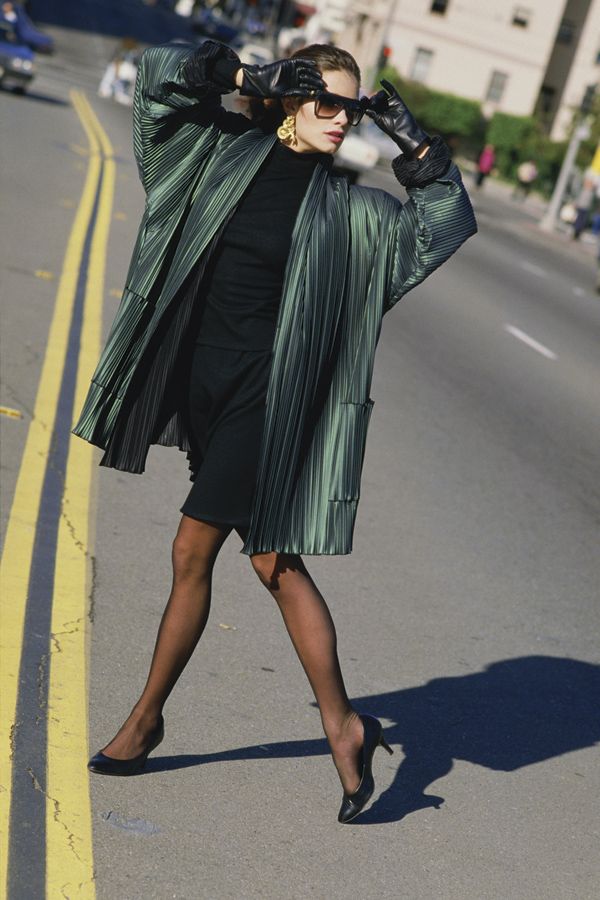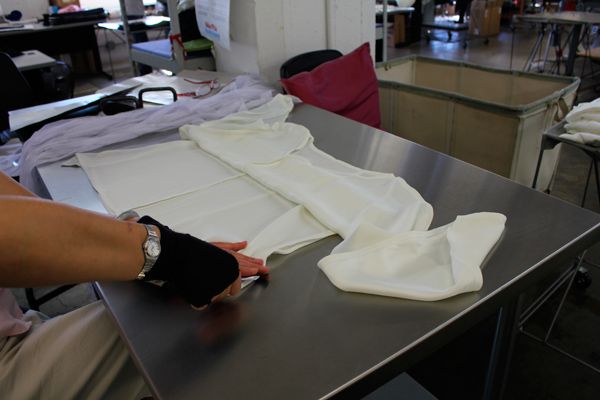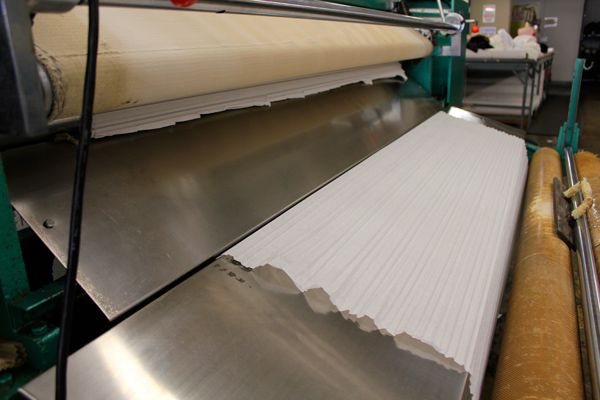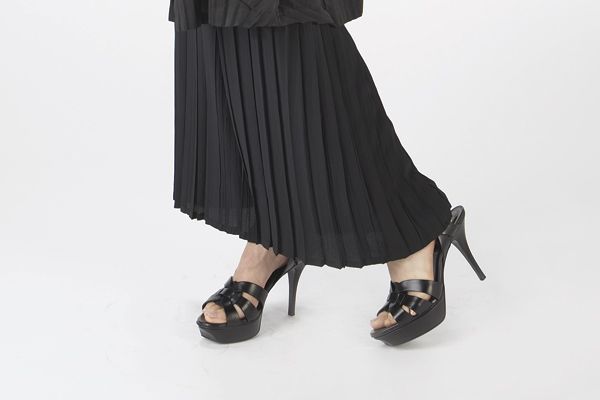
Babette's original pleated raincoat design, introduced in the early 1980's.
For Threads no. 159, I interviewed designer Babette Pinsky for the Designer Spotlight series. If you aren’t familiar with her work, she creates fascinating garments with textiles that she pleats, folds, scrunches, and otherwise manipulates into unique and very flattering designs.
We didn’t have enough room on the printed page to cover the techniques she uses in her Oakland, California, factory, to pleat fabric by hand and machine. There was more to my interview with Babette, and you can read it here, including her description of three methods she uses to create textures in her garments. You can view the new Babette collections for 2012 at BabetteSF.com.
THREADS: Do you pleat the fabric or the garment?
BABETTE PINSKY: We never manipulate yardage. We design the garment, cut it, try to anticipate how much fabric will be consumed by pleats and then try a sample. The garment is cut first. Sometimes each piece is pleated, sometimes part of the garment is pleated, and sometimes the whole garment is pleated.
TH: What qualities do you look for in a fabric?
BP: All of the pleated fabrics are either polyester or nylon, because nothing else will hold a pleat permanently. So we look for interesting polyester fabrics.
TH: Tell us how you manipulate fabric.
BP: We use three types of pleating. The first is hand-pleating, in which someone sits at the table with a cut piece or the whole garment in front of them. With their hands they twist, fold or bunch it. After it is ready, the fabric is tied in shape, and then it is baked in an autoclave.
TH: How hot does the autoclave get?
BP: I think it’s about 240 degrees. It’s not terribly hot, but it applies heat and pressure to set the pleats. The autoclave is maybe 6 feet by 10 feet long. It looks like what dentists used to have in their offices for cleaning instruments.
TH: What is the second pleating technique?
BP: The second would be machine pleating. A pleating machine looks like a big cylinder, turning very slowly. It actually has heated knives in it, running the long way. The knives can be adjusted so that you can get a 1-inch pleat, a 2-inch pleat, a ¼-inch pleat, etc. The knives are heated and coated with oil. The fabric goes through between two sheets of paper so that it doesn’t get burned. The pleating machine only does straight lines. If you put a sleeve through cuff first, you’re going to get a little short sleeve, a little box. If you put the sleeve in along the over- or under-arm, you’ll end up with a narrow sleeve.
TH: And the third?
BP: The third type of pleating is called pattern pleating. It means that the fabric is pleated between pieces of paper that are scored identically. Let’s use the example of a fan. If you have two fans that fold identically and you take a piece of cloth and you put it between them then close the fans, the cloth will take on the fans’ contours. You could tie the fans closed, and toss them and the cloth together in the autoclave. We use a heavy paper that can be reused about 100 times. The paper is scored by hand. The two layers must match exactly. (With this method) we can do curves, we can do angles; we’ve done little boxes, all kinds of stuff.
TH: How many times would you say you go back and forth on a garment to get it right?
BP: If we are lucky, once. Usually we are not, though. We fit the first sample. We fit the second sample with corrections. If the corrections aren’t major, we’ll go into what we call “duplicates.” I think right now we make seven duplicates, and they are for our salesmen and trunk shows. It’s like a mini-production. Before we go into full production, we fit the duplicates and make sure everything is just right. It’s a minimum of three times and it can be four, five, six times. There’s always one garment that we have to cut and cut and cut. Especially if we are doing a new shape and it’s complicated. One of the reasons I can’t understand how people sew at home is that it is never right the first time. But I guess at home you just rip it out and fuss with it!
For the rest of Babette’s interview, be sure and pick up the new issue of Threads, no. 159!










































love this - is there a way to make permanent pleats like this at home? In the dryer, for example?
Love this coat!! Anyway of getting a pattern of it??
Some years ago, I pleated an acetate fabric using an iron only and it holds pretty well, although the garment hasn't been washed very often. If I had a suitable polyester or nylon fabric, I would give pleating a try using an iron. Be warned, however, that making the pleats is fiddly work and working with slippery fabrics would be slow going and the pleats would need to be basted in place. Maybe think twice about it!
Or baking in a low oven? (Only half kidding). Beautiful pleating.
On a smaller scale, you could pleat first and cut your piece out second., Try using your sewing machine's pleater, perfectly aligned, at both ends of the fabric. Then stretch and machine baste. Lastly, press in the pleats with a press (not iron). I even found an old mangle iron circa 1960 to do neat things otherwise not possible with the usual sewing room equipment. But what I wouldn't give for a second pair of hands to help with this and other manual-intense projects. My ambitions overwhelm my osteoarthritis, which I regret the following day.
am attempting to make gathers on a victorian gown costume that unfortunately is made out of a pillow weight fabric. I have to take a lot of fabric and pleat it down to about 8 inches.....suggestions?
For really fine pleats, you could pleat the fabric with a smocking pleater...